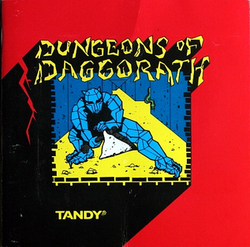Dungeons of Daggorath
| Dungeons of Daggorath | |
|---|---|

Cover artwork.
|
|
| Developer(s) | DynaMicro |
| Publisher(s) | Tandy Corporation |
| Designer(s) | Douglas J. Morgan |
| Engine | Custom |
| Platform(s) | TRS-80 Color Computer, Dragon computer |
| Release date(s) | 1982 |
| Genre(s) | Dungeon crawl |
| Mode(s) | Single player |
Dungeons of Daggorath is one of the first real-time, first-person perspective role-playing video games. It was produced by DynaMicro for the Tandy (RadioShack) TRS-80 Color Computer in 1982.
Dungeons of Daggorath was one of the first games that attempted to portray three-dimensional space in a real-time environment, using angled lines to give the illusion of depth. It followed the 1974 games Maze War and Spasim, written for research computers, and the first 3D maze game for home computers, 3D Monster Maze, released in 1981. The game Phantom Slayer, which like Daggorath was released in 1982 for the Color Computer, also featured monsters lurking in a maze. While Daggorath was visually similar to these games, it added several elements of strategy, such as different kinds of monsters, complex mazes, different levels of visibility, and the use of different objects and weapons.
The player moves around a dungeon, issuing commands by means of typing — for example, typing "GET LEFT SHIELD" or "USE RIGHT TORCH" (or abbreviations such as "G L SH" and "U R T"), gathering strength and ever more powerful weapons as the game progresses. Various creatures appear, and can often be heard when they are nearby, even when not visible. The object of the game is to defeat the second of two wizards, who is on the fifth and last level of the dungeon.
A unique feature of the game is a heartbeat which rises as the player moves and takes actions within the virtual environment. The heartbeat is a direct predecessor of the "health" indicator in later games; the higher the heart rate, the more vulnerable the player is to attack. The player can faint from overexertion, in which case there is the risk of being attacked while defenseless. This heartbeat system was used instead of numerical statistics such as hit points or vitality, and was inspired by arcade games, specifically 1978's Space Invaders where a heartbeat-like sound gradually increases pace as enemies advance towards the player.
...
Wikipedia
